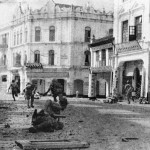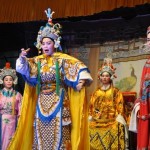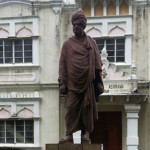A Chinese doorway is more than a physical structure that defines passage from one space to another. It is a symbol of safety, hope, protection, sanctuary and resting station to the early Chinese immigrants and indentured workers.
Door Design And Construction.
| a) | Utilitarian | 1800 to 1900s simple wood shuttle with minimal decoration |
| b) | Neo Classical | 1900 to 1930s elaborate and ornately carved |
| c) |
Art Deco/Art Nouveau
|
1930s to 1940s simple lines and geometric patterns |
| d) | Post War | no ornament and totally utilitarian |
Door control our passage and transmission of light, vision, sound, heat and cold.
| Types of door | a) | Half door placed in lieu of main door to give privacy and ventilation when main door is opened. |
| b) | Main door (ta men) | |
| c) | Wooden Door (mu men) | |
| Door Construction | – Half and main door: Elaborate and aesthetic wooden door: Plain, strong and functional. | |
| Techniques | – Wedge and full mortise and tendon joints tongue and groove joints edge of panels beveled. | |
| Wood Used | – Red meranti ( medium hardwood ) cengal and merbau. | |
| Finishes | – Clear lacquer, lacquer with pigments, gilding with gold leave and after 1950s gloss paint. | |
| Colors | a) | Blue signifies peace. |
| b) | Red signifies good fortune and happiness. This color is most widely used in different tones and shades. | |
| c) | White signifies sorrow. | |
| d) | Black is uses for outlining. | |
| e) | Yellow seldom used in domestic doorways, being an imperial color. | |
| Decorations | – Carved through or as bas-relieved. | |
| Bats pian-fu |
– Good luck symbols that signifies good luck and happiness. Five bats shown together represent the five blessings – a long live, riches, good health, a love of virtue and a good natural death. | |
| Dragon lung |
– Symbol of natural male vigor and fertility, east and royalty. The dragon and phoenix together embody the male and female essences and thus symbolize the married state. | |
| Lion shi-zi |
Emblem for loyalty and bravery, popularly used as guardian of official buildings and temples. | |
| Peony mu-tan |
Queen of flowers, emblem of wealth, and. It also symbolizes spring, renewed growth. | |
| Vase ping |
Phonetically identify with peace Filled with flower it signifies that those who use doorway may enjoy peace at all times. | |
Signages
Above the door and windows and on both sides of the door are richly carved calligraphy signage panels. The calligraphy were in a variety of styles and a rich tradition that trains the mind, body and spirit, one of the tools fostering the development of a Confucian gentlemen. The signage is made from Jelutong wood.
Inscribed in the signage on top of the door is the name of the district ,village or province where the house occupant originally comes from in China. From it we can deduce the surname of the occupants.
The signage panels done in poetic verses on both side of the door normally extol the Confucian ethics and the high esteem of the house occupant held by well wishers . These signage were usually presented by friends and well wishers to the house occupants during the housewarming gathering.
Lanterns
The lantern hung right in the center of the doorway is known as the Heavenly Lamp ( thean teng ) in honor of the Jade Emperor. It is of six-sided shape made of wooden frames with clear glass panels. It is also hung by childless couples who wishes for a son, hopefully by the grace of the Jade Emperor.
A pair of cloth lantern ( tua teng ) with one painted with clan surname and the other with the district where there ancestor originated were hung on both sides of the main door. The calligraphy is done in red color with colorful geometrical design and flower and birds. Drawings of dragon are only for kongsi and temple lanterns. During time of bereavement the lantern are taken down. They are hung up after observing the required mourning period. In the past a pair of white lanterns were hung during the mourning period. This is no longer in practice.
Those childless couple or without son to continue may also borrow the cloth lantern from their clan kongsi, after prayer and pledges to their clan kongsi patron deity.
The Hokkiens are the only southern Chinese community practicing the hanging of lanterns at their doorways.
Builders and Carpenters
Construction of doorways were supervised and carried out by master craftsmen and master builders before the introduction of western trained Chinese architect.
Before the 1930s the builders and carpenters were Cantonese of the Sing Ning dialect group but after that the Hokkien came into the trade as contractor, builders and carpenters. The carpenters were master joiners and skilled wood carvers at the same time.
The skills and aesthetics of traditional craftsmen, carpenters and builders were passed down through the generations. Under the old guild system, the crafts and skill were passed from master to apprentice. An apprentice lasted five years, during which time the novice were provided only food and board.
The long period of apprenticeship tested the endurance and perseverance of the novice and deters many from learning the craft. The introduction of new technology, power tools, availability of new techniques and new materials, inability to recruit apprentice and the passing of the old craftsmen has threatened the continuation of this traditional craft and trade.
Types of doorways
| a) | working class |
| b) | straits eclectic |
| c) | detached houses |
| d) | associations and guilds |
| e) | kongsis and temples |
Summary
In the past these type of beautifully crafted and filled with tradition doorways were located in Singapore, Malacca, Kuala Lumpur and Penang. Most of these doorways have disappeared in the other cities with the exception of those in Penang. Those still surviving in Penang are under severe threat of neglect, damage by pests, vandalism, theft, irresponsible renovation, lack of enforcement by local authorities, and more dangerously the wholesale removal for new multi storey development as most of the houses are rent decontrolled units.
The other concern is the decreasing number of traditional craftsmen, the lack of interest by the various guilds and authorities to promote the crafts, the lack of recognition and the inability to attract new apprentice.
|
David Yeo |


